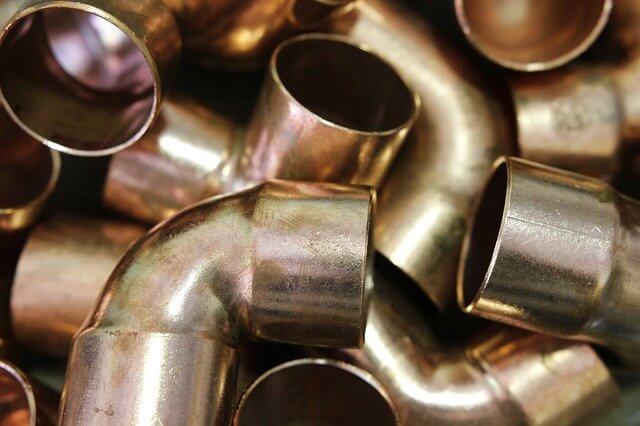Blue on Copper Water Pipes Green Corrosion on Copper Pipes
When taking care of your home, one thing you're likely to forget is pipes. Most people don't check their plumbing until some issue arises. When you do finally look at them, you may notice they have changed color. Why do copper pipes turn green, and is this a bad sign?
Although you perhaps don't know why do copper pipes turn green, you have probably noticed something similar happening to other items. For example, most people know that copper jewelry turns green after a while. Does the same happen to pipes, or do different processes cause the color change? If you're eager to learn this, you're in the right spot.
Why Do Copper Pipes Turn Green?

Today, people don't make pipes from the same materials as they did decades ago. Old homes have pipes made from several metals, such as:
- Steel
- Iron
Lead Modern pipes, however, are typically made from PVC and copper. [1]
These materials have many benefits, such as their lightweight, durability, and ease of use. However, both kinds of materials can experience some problems over time. Copper pipes are prone to changing their reddish color to green, blue, or even black. But what causes copper pipes to turn green?
The greenish color you see on copper pipes is calledpatina. There are several reasons behind the occurrence of patina. Not all are dangerous, but you should still deal with them.
Here are two main reasons why do copper pipes turn green:
Contact with Chemicals
When your pipes turn dark green to black color, this is usually due to the presence of sewer gas. High sulfur levels cause the copper to darken, and it gets a distinguish dark green or even entirely black color. This might also mean that your pipe contacted some non-compatible metals, such as galvanized steel. While this isn't extremely dangerous, it can be a potential hazard. This is especially true if you're dealing with cheap copper.
Sometimes, builders make pipes from cheap copper with a high impurities amount. At first, there is no way you can notice this. However, as time passes, these impurities will show on the pipe's surface, causing it to darken. Cheap copper can crack faster than a high-quality one. Not to mention that you cannot know what it's made of and whether it's a potential health hazard. It is always important to trust your plumber.
Corrosion
Corrosion is the main reason why do copper pipes turn green. In fact, a patina is a result of oxidation that happens when copper is exposed to air and water. While short-term exposure isn't an issue, after a while it creates patina. Patina is, in fact, the oxidized layer on copper that turned to green or bluish-green. The color is caused by copper oxide, a product of copper mixing with oxygen.
While patina on itself isn't harmful, if left untreated it will cause the corrosion of the pipe and burst pipe. The green color you see is, actually, the rusting of the copper. While the commonly seen iron rust is red, copper oxidizes to an opposite green color.
Will Patina Cause Pipe Failure?
As you probably know, corrosion is rarely a good thing, especially when it comes to plumbing. Still, you should keep in mind that patina itself isn't an issue. In fact, it is often very good for your pipes. A layer of oxidation has some benefits for your pipe. This is mostly because it serves as an additional water-proof level that prevents any further reactions from happening. In other words, you can say patina keeps your pipes safe from harmful chemicals.
However, if you leave the patina on for a long time, it can cause the pipe to corrode. Corrosion will slowly eat away the plumbing, which will then become more fragile. Also, this can indicate that you have a leak somewhere inside your pipe.
If you notice greenish water coming from your green pipes, this can indicate a much more serious issue. Since now you know why do copper pipes turn green, you should probably be aware of what this means. When you have a change in water coloration, you have corrosion inside the pipe. This is extremely tricky, as you may not always be able to locate the area that corroded.
Drinking water stained with patina isn't healthy.
It can cause severe issues, including hair loss and skin damages.
Causes of Leaks
Do you know why do copper pipes turn green even if you don't have a visible leak? It doesn't take too much water to cause this issue. Actually, a minor pinhole leak can be the culprit behind patina. This is why you usually won't even notice that there is a water leak on or inside your pipe.
- If you use well water with a low pH level, it can damage the pipe. In fact, this is the main culprit behind patina in households with well water. When you notice your copper pipe turning green, the first thing you should do is check the water's pH level. If the pH is under 6.5, it can damage the plumbing and cause pinhole leaks. This is dangerous on many levels, as it can cause lead to enter your water supply.
- Chloramine is a substance made with chlorine and nitrogen that is commonly used to clean municipal water supplies. However, it can cause tiny leaks in your pipes, which will end with patina.
- Old pipes, as well as outdated water heaters, are prone to corroding. This causes metallic particles to come in contact with your plumbing. Actually, these particles can scrape the copper, causing pinhole leaks.
How to Get Rid of Patina
As we've already mentioned, having patina is usually a sign of a leak. While this leak might be very small at the start, it can quickly turn into a big plumbing hazard. If you suspect you have a leak, you should always contact a plumber. Don't let your house ends up ruined due to water damage. A professional soldering copper pipe problems is the best solution, as it deals with the core of the issue.
However, we'll focus on the aesthetics. Let's imagine you have fixed the leak, or that the water came from an external source. If this is the case, you'd probably want to get rid of that ugly, green color on the copper. Here are a few ways you can do that.
Color Over the Pipe
The most logical solution is to color over the green. But, can copper pipes be painted, at all?
You shouldn't paint copper pipes with paints that aren't meant for copper. While the paint can't ruin the pipe, the copper can eat away the paint. In fact, a lot of regular paints will just peel away from copper. This is especially the case if the pipe happens to corrode at any point in time. The corrosion will only make the paint peel off quicker. When the paint peels, this provides a space for moisture to lean on. This will only make the pipe corrode at a much faster pace.
However, there are some paints specifically designed for copper. A good choice would be Krylon General Purpose Spray Paint, which is suitable for copper pipes. It also comes in realistic copper color, so you can make the patina almost entirely invisible. While this won't cure the source of the problem, it can certainly make your pipes look as good as new.
Natural Solutions

The patina reacts to acids, which is good, as many everyday household products are very acidic. Here are the ones that can give you the best result.
- Lemonade. Lemon juice is very acidic, making it a great cleaning agent. It also smells well, which is always a bonus. To create a good lemon juice for cleaning, make a 1 to 1 tap water and lemon juice mixture. Soak the pipe with it for about half an hour, then scrub it with a brush. This should be enough to get rid of that ugly green tint.
- Black coffee.Coffee seems like the last thing you'd want to clean things with. It stains everything, from clothes to teeth. However, it is very acidic, making it great for cleaning patina. Don't use hot coffee, unless the pipes are made to sustain extremely hot temperatures. Wait for the coffee to cool, then, just like with lemon juice, soak the pipe with it. Just be careful not to spray it on the walls, as it will make them dirty! Wait for a few minutes, then scrub everything with a brush or just a damp cloth. This will make your pipe look as good as new.
- Vinegar. All kinds of vinegar are highly acidic. Black vinegar, apple cider vinegar, white vinegar – doesn't matter, it's acidic. Actually, it is so acidic that you don't even have to soak the pipe with it. Spray undiluted vinegar on the pipe and scrub it with a sponge or a brush. If the tint is persistent, let the vinegar sit for a few minutes, then scrub again. This is great for those old stains that really won't go away.
You might also want to make a paste from vinegar, salt, and flour. Mix a teaspoon of salt with a cup of vinegar and the desired amount of flour. This might make it easier to create a mixture that will sit well on the pipe before scrubbing. Sometimes, the flour isn't necessary and it's only there for the texture.
Once you have cleaned the patina from the pipe, you can rub everything with olive oil. Olive oil will make the pipe shine like it's brand new. Also, it won't cause any damage and it's safe to use, without leaving a sticky residue. This will bring a luxurious look to the visible part of your piping system.
Acetone
Acetone is yet another household item that can help you get rid of the patina, although you have to be careful. This is a pH neutral solvent that is highly flammable and very strong. Most paint thinners and polish removers contain it. It can eat away some materials, so you shouldn't let it stay on the pipes. Rinse it away immediately after use. Also, acetone will remove most paint you may have on the pipes, so keep that in mind.
Bottom Line
It's very important to know why do copper pipes turn green. While the patina, the green tint, isn't dangerous on its own, it is usually a sign of many more severe issues. When you notice patina and the environment isn't typically moist, you should immediately contact a local plumber. If you have a pinhole leak, it can quickly tear and become much bigger, becoming dangerous. Leaks can result in severe water damage, and this might even ruin the entire structure of your home. You should deal with them while the issue is minor.
Source: https://plumbertip.com/why-do-copper-pipes-turn-green/
0 Response to "Blue on Copper Water Pipes Green Corrosion on Copper Pipes"
Post a Comment